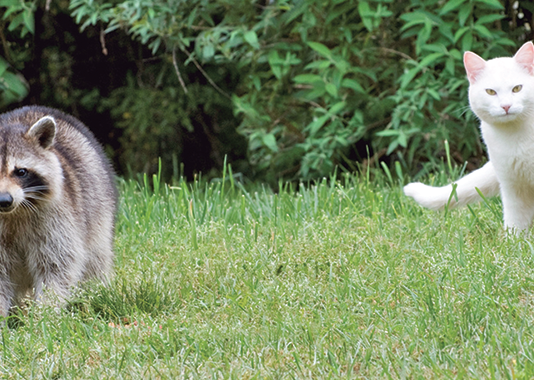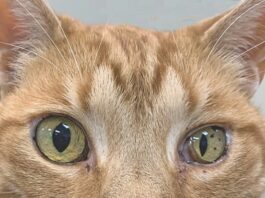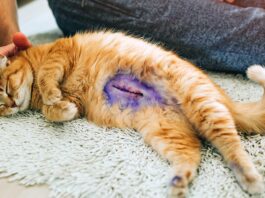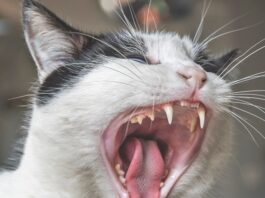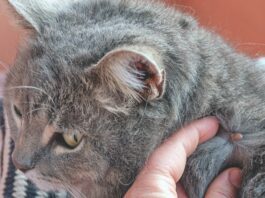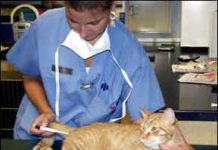Short Takes: January 2012
Chronic gingivostomatitis (FCGS) is a significant disease of cats causing ulcerative, painful lesions in the mouth. Unfortunately, the cause of this condition is not always clear, but feline calicivirus has been speculated to play a part in some cases. Medical treatment of this condition has largely remained unsuccessful. Interferon is a protein produced by animals to fight virus infections, and investigators examined the potential of this substance — which can be produced artificially and given orally — to treat FCGS.
Lung Disease: Serious and Common
Like their human counterparts, feline lungs are bag-shaped, elastic organs, two in number, located on either side of the heart and occupying most of the space in the chest cavity. They are virtually identical in structure to human lungs as well, functioning in the same manner and fulfilling the same fundamental purposes — removing carbon dioxide from the bloodstream and keeping the blood constantly supplied with life-sustaining oxygen. The lungs perform their vital functions by means of two processes — properventilation and perfusion — explains Richard Goldstein, DVM, an associate professor of small animal medicine at Cornell University’s College of Veterinary Medicine.
Are You Allergic to Your Cat?
If you are allergic to your cat, don’t despair. You are actually far from alone — but luckily, there are increasingly effective methods for dealing with allergies. Believe it or not, at least one in three cat owners has allergies to feline friends. For some, the allergic reaction is limited to itchy, watery eyes. Others may develop asthma or other serious breathing problems. The major culprit behind human allergic reactions to cats originates from cat skin, according to David Rosenstreich, MD, Chief of the Division of Allergy and Immunology at the Albert Einstein College of Medicine and Montefiore Medical Center, Bronx, NY.
In The News: New Anesthesia Guidelines
Due to the many important variables that need to be considered, the American Animal Hospital Association (AAHA) brought together a group of experts to produce new guidelines for anesthetizing cats and dogs — stressing the importance of comprehensive, individualized anesthetic plans to minimize morbidity and optimize conditions.
Are Prescription Diets Necessary?
Trying to adjust your cat’s diet because of a serious medical condition is undoubtedly a good idea. But experts insist that there is a right way and a wrong way to go about it. Some problems may respond readily to a dietary adjustment, while other problems can be more vexing and require treatment aside from nutritional changes.Firstly, remember that therapeutic diets do not cure diseases. They can alleviate clinical abnormalities on a temporary basis, and alleviating these abnormalities can certainly help our beloved pets feel better and give them a higher quality of life.
Ask Elizabeth: January 2012
We adopted a new kitten from a local rescue group last month, and she is just perfect. Although she had been tested for the feline leukemia virus and FIV by the terrific group that saved her from the street, we took her to our veterinarian right away so that she could be examined before we introduced her to our two older cats. After a clean bill of health, we brought Bunny home, and she has become a well-integrated part of the family. The problem is that before we scheduled her spay surgery, she came into heat. What a scene!
Hyperthyroidism: Controllable
At first, the owner worried that her cat Misket had worms. Her 11-year-old pet had a ravenous appetite, yet she appeared to be losing weight and her coat looked dull and unkempt. The veterinarian took a blood test and came up with a surprising diagnosis to her owner: hyperthyroidism, or overproduction of thyroid hormones. Feline hyperthyroidism tends to occur in elderly cats; 95 percent of the cats that develop this disease are older than eight and the mean age of the victims is about 12 years, according to John F. Randolph, DVM, professor of medicine in the section of small animal medicine at Cornell’s College of Veterinary Medicine.
A Greater Understanding of FIP Treatment
Feline infectious peritonitis (FIP) has long been a difficult diagnosis with little hope. But a new medication shows promise — and a cutting-edge genetic breakthrough may also be within reach. This progress was announced to 200 veterinarians, cat breeders and cat lovers at the 33rd annual Winn Foundation Symposium in Reston, VA.
Taking Your Cat’s Temperature
You may wonder: How exactly can I take my cat’s temperature without being bitten or scratched to smithereens? Obviously, you will need to do it carefully, and if possible, with a partner. Additionally, it’s a smart idea to first have a trained staff member at your veterinary hospital demonstrate the technique for you. There may be a time when your cat is recovering from an illness and you’ll be asked by your veterinarian to monitor her temperature, so it’s a useful skill to aquire.
Taking Your Cats Temperature
You may wonder: How exactly can I take my cat’s temperature without being bitten or scratched to smithereens? Obviously, you will need to do it carefully, and if possible, with a partner. Additionally, it’s a smart idea to first have a trained staff member at your veterinary hospital demonstrate the technique for you. There may be a time when your cat is recovering from an illness and you’ll be asked by your veterinarian to monitor her temperature, so it’s a useful skill to aquire.
Short Takes: December 2011
Unfortunately, feline lower urinary tract diseases (FLUTDs) are common. Urethral obstruction (UO) is believed to occur more commonly in young cats and almost exclusively in male cats, although veterinary literature has limited information regarding the risk factors for UO. The most common etiology of UO in cats is urethral plugs, and the most common signs of UO include stranguria, dysuria and pain, and varying degrees of systemic signs.
Feeding Your Diabetic Cat
Diabetes mellitus in cats is similar to the human disease. The cat cannot efficiently use the sugar (glucose) she takes in with her diet. This is because either she is not producing sufficient amounts of insulin — which regulates the body’s use of sugar — or the cat’s body cannot respond to insulin. One key to treating a diabetic cat is to stabilize her diet and feeding times to control her weight and the amount of glucose in her blood.

